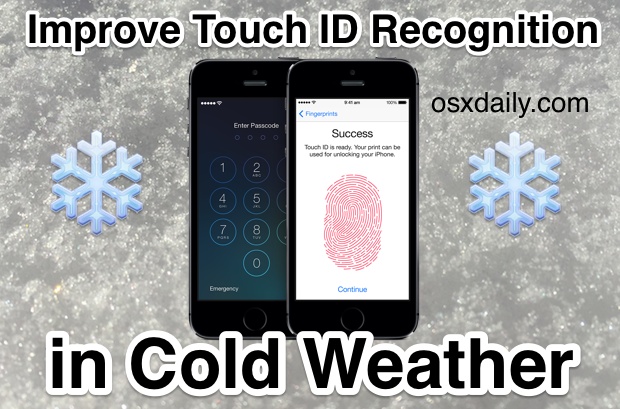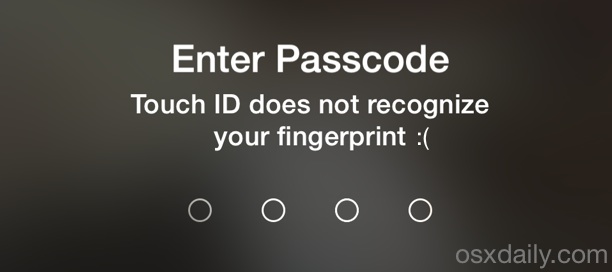Touch ID Not Working in Cold Weather? Here’s a Fix

Many iPhone users have noticed that Touch ID becomes finicky in cold weather, often not working at all when the temperatures drop in winter. Or at least, that’s what it seems like, but the real culprit is quite likely to be your skin and the effects of colder climates on fingerprints, which is what Touch ID is using to recognize and unlock your device. Fortunately, a solution to improving Touch ID recognition in colder weather is quite simple.
What you’ll want to do is add a new fingerprint to Touch ID while your hands are cold (which usually means the skin is more dry too), matching the general conditions where Touch ID is failing on a regular basis. This is easy to do if you’re in a cold climate, but a bit more challenging if you only occasionally visit a land of chilly temps, like a ski resort, so you’d just want to remember to add a new fingerprint to Touch ID when in those conditions. You can think of this as a weather dependent variation on the reliably unlocking with Touch ID by adding the same fingerprint multiple times trick, which works very well to improve recognition in general.
The steps for the cold climate trick are pretty straightforward:
- Be in an environmental condition that represents colder weather when Touch ID recognition is not working consistently or at all
- Open the Settings app on your iPhone and go to “Touch ID & Passcode”
- Tap on “Add a Fingerprint”
- Add a new cold weather fingerprint to Touch ID, you may want to give it a label like “cold thumb” for easy reference – be sure to add this in addition to your primary fingerprint used to unlock the iPhone or iPad
- Enjoy using Touch ID even in adverse weather conditions
If you have already hit your 5-finger limit in Touch ID, you’ll need to remove one of the fingerprints from the iOS device (hopefully Apple will allow additional fingerprints in the future for this climate reason alone) while you’re in Touch ID Settings.
This seems to be a really common issue for many iPhone owners who live in places with strong seasons, or even when visiting a location with dramatically different weather. Since many users setup their iPhone in a different season than when they’re experiencing the Touch ID irregularities, they often only have that single fingerprint added during the initial device setup anyway. Thus, adding the new fingerprint to Touch ID while in the alternative weather condition almost always resolves the recognition troubles in those chilly temperatures and when you have drier skin.
This apparently works in reverse too for those coming from constantly cold weather to hot temperatures, like if you were to live in the South Pole and visit Hawaii, your fingerprints and skin texture would likely change a bit and Touch ID could become unresponsive. Again, just add a new print to Touch ID, and it should work well again.
For what it’s worth, if you try to use the same fingerprint that is not detected multiple times, the iPhone will require that you enter a passcode manually because “Touch ID does not recognize your fingerprint”, this is what that error message looks like:

Did the cold-finger winter weather Touch ID trick work for you? Let us know in the comments.


Some people have restricted circulation in the cold. The sensor isn’t just taking a picture of the skin surface. It needs blood flow near the surface as well.
The instructions sound great but how do I get to my settings app if the phone won’t recognize my touch ID?? I’m locked out.
Enter your passcode instead of Touch ID to get into the Settings
I have entered the passcode. Many times. It still doesn’t unlock. Do I need to restore??
I tried making an id for a cold finger, but it won’t even register my finger’s presence at all. the screen stays blank and after so long it “reminds” me to put my finger down, when it already is! it’s not even just outside, but after i’ve been in a room that’s cooler for a few hours. still nothing
I now realize this Touch ID not working thing is a serious problem because your website, which is quite popular obviously, has written about it, and then another website called Macssues also wrote the EXACT SAME THING about environmental conditions making Touch ID unresponsive a week later! Widespread problem with Touch ID, I think!
I’m about ready to give up on my iPhone- 5S- it doesn’t let me ‘tap’ to turn off/snooze the alarm most mornings, I can’t dial a number without rubbing the tips of my fingers raw if I’m outside in Michigan, Siri sucks, fingerprint ID hasn’t worked in months… The list goes on.
You can hit the volume button to Snooze the iPhone alarm. Add a new Fingerprint to Touch ID and it works much better, basically need seasonal fingerprints because it doesn’t matter the climate they all seem to impact recognition. Hot, cold, wet, dry, washing your hands, using hand lotion, etc, it’s finicky. And Siri, yea, I agree, it works 50% of the time sometimes.
I also discovered that the Touch ID is impacted by a build up of oils/dirt on the surface of the home button. Once I wiped it off it improved the recognition.
Why don’t you try wiping your hands off or putting them in a warm pocket for a minute or even rubbing them together? Too low tech?
Because that does nothing to change the physical texture of your fingerprint that becomes physically different when your hands are in cold dry weather for an extended period of time. If you set up Touch ID in the summer when it’s warm, you’ll probably have problems once your hands dry out. Go to Minnesota in the winter and your hands dry out, try it out. The problem is dry skin, and Touch ID not recognizing the difference in dry skin. Did you read the article?
fortunately we can still use a four digit code
Not for Apple Pay, it doesn’t.
I fear fingerprint variations will turn out to be a killer of a problem for Apple Pay. Image you’re ready to pay for something and — OOPS! your finger is too cold (or too warm, or wet, or dried out, or you recently applied skin cream) — so you can’t pay. After about one awkward experience like that a person won’t rely on his/her iPhone to make payments. It’s got to get more reliable. I’ve trained all 5 positions with the same finger and a day later the finger isn’t recognized, probably because of some skin variation.
I run into this often too. Touch ID is not reliable enough to use for something like Apple Pay because it can barely unlock my iPhone reliably. It’s not as bad as Siri (does Siri ever work for anyone?) but it’s maybe a 25% failure rate with Touch ID, enough to be so annoying that it’s unreliable.
fortunately we can still use a four digit code
I had the reverse situation happen where I set up Touch ID in the dry winter, and had it become much less reliable by the wetter spring. So yes, it works both ways!
Also if your fingers are wet or greasy, then Touch ID will become less responsive, so wipe your fingers on your shirt first if there is no climatic variation that could be the culprit.
By the way, we have ten digits, why doesn’t Apple make the Touch ID limit set to 10?